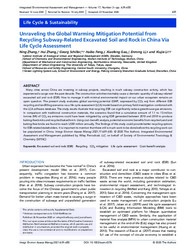Unraveling the Global Warming Mitigation Potential from Recycling Subway‐Related Excavated Soil and Rock in China Via Life Cycle Assessment
Zhang, Ning
Zhang, Hui
Schiller, Georg
Feng, Haibo
Gao, Xiaofeng
Li, Enming
Li, Xiujie
Zhang, Ning; Zhang, Hui; Schiller, Georg; Feng, Haibo; Gao, Xiaofeng; Li, Enming; Li, Xiujie, 2021: Unraveling the Global Warming Mitigation Potential from Recycling Subway‐Related Excavated Soil and Rock in China Via Life Cycle Assessment. In: Integrated Environmental Assessment and Management, Band 17, 3: 639 - 650, DOI: 10.23689/fidgeo-4356.
 |
Dokument öffnen: |
Many cities across China are investing in subway projects, resulting in much subway construction activity, which has experienced a surge over the past decade. The construction activities inevitably cause a dramatic quantity of subway‐related excavated soil and rock (ESR). How to manage it with minimal environmental impact on our urban ecosystem remains an open question. The present study evaluates global warming potential (GWP, expressed by CO2 eq) from different ESR recycling and landfilling scenarios via a life cycle assessment (LCA) model based on primary field investigation combined with the LCA software database. The study results illustrate that recycling ESR can significantly reduce greenhouse gas emissions. In comparison with traditional construction materials, the scenarios found that a cumulative amount of 1.1 to 1.5 million tonnes (Mt) of CO2 eq emissions could have been mitigated by using ESR generated between 2010 and 2018 to produce baking‐free bricks and recycled baked brick. Using cost–benefit analysis, potential economic benefits from recycled sand and baking‐free bricks are found to reach US$9 million annually. The findings of this study could provide better recycling options for ESR‐related stakeholders. It is important to mention that there still is much work to be done before this recycling work can be popularized in China. Integr Environ Assess Manag 2021;17:639–650. © 2020 The Authors. Integrated Environmental Assessment and Management published by Wiley Periodicals LLC on behalf of Society of Environmental Toxicology & Chemistry (SETAC) KEY POINTS:
This study focuses on the global warming potential (GWP) assessment of excavated soil and rock (ESR).
Cumulative CO2 mitigation potential by recycling ESR was calculated.
More than US$8 million profit could have been reached annually between 2006 and 2018.
Cumulative CO2 mitigation potential could have been as high as 1.5 Mt from 2010 to 2018.
Statistik:
ZugriffsstatistikSammlung:
Schlagworte:
Excavated soil and rock (ESR)Recycling
CO2 mitigation
Life cycle assessment
Cost–benefit analysis
This is an open access article under the terms of the
Creative Commons Attribution‐NonCommercial‐NoDerivs License, which permits use and distribution in any medium, provided the original work is properly cited, the use is non‐commercial and no modifications or adaptations are made.

